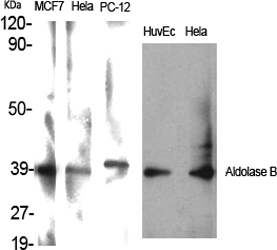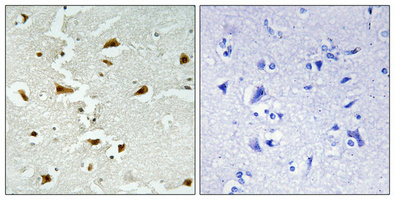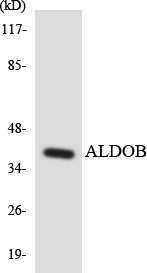Aldolase B Polyclonal Antibody
- Catalog No.:YT0192
- Applications:WB;IHC;IF;ELISA
- Reactivity:Human;Mouse;Rat
- Target:
- Aldolase B
- Fields:
- >>Glycolysis / Gluconeogenesis;>>Pentose phosphate pathway;>>Fructose and mannose metabolism;>>Metabolic pathways;>>Carbon metabolism;>>Biosynthesis of amino acids;>>HIF-1 signaling pathway
- Gene Name:
- ALDOB
- Protein Name:
- Fructose-bisphosphate aldolase B
- Human Gene Id:
- 229
- Human Swiss Prot No:
- P05062
- Mouse Gene Id:
- 230163
- Mouse Swiss Prot No:
- Q91Y97
- Rat Swiss Prot No:
- P00884
- Immunogen:
- The antiserum was produced against synthesized peptide derived from human ALDOB. AA range:111-160
- Specificity:
- Aldolase B Polyclonal Antibody detects endogenous levels of Aldolase B protein.
- Formulation:
- Liquid in PBS containing 50% glycerol, 0.5% BSA and 0.02% sodium azide.
- Source:
- Polyclonal, Rabbit,IgG
- Dilution:
- WB 1:500 - 1:2000. IHC 1:100 - 1:300. ELISA: 1:20000.. IF 1:50-200
- Purification:
- The antibody was affinity-purified from rabbit antiserum by affinity-chromatography using epitope-specific immunogen.
- Concentration:
- 1 mg/ml
- Storage Stability:
- -15°C to -25°C/1 year(Do not lower than -25°C)
- Other Name:
- ALDOB;ALDB;Fructose-bisphosphate aldolase B;Liver-type aldolase
- Observed Band(KD):
- 39kD
- Background:
- Fructose-1,6-bisphosphate aldolase (EC 4.1.2.13) is a tetrameric glycolytic enzyme that catalyzes the reversible conversion of fructose-1,6-bisphosphate to glyceraldehyde 3-phosphate and dihydroxyacetone phosphate. Vertebrates have 3 aldolase isozymes which are distinguished by their electrophoretic and catalytic properties. Differences indicate that aldolases A, B, and C are distinct proteins, the products of a family of related 'housekeeping' genes exhibiting developmentally regulated expression of the different isozymes. The developing embryo produces aldolase A, which is produced in even greater amounts in adult muscle where it can be as much as 5% of total cellular protein. In adult liver, kidney and intestine, aldolase A expression is repressed and aldolase B is produced. In brain and other nervous tissue, aldolase A and C are expressed about equally. There is a high
- Function:
- catalytic activity:D-fructose 1,6-bisphosphate = glycerone phosphate + D-glyceraldehyde 3-phosphate.,disease:Defects in ALDOB are the cause of hereditary fructose intolerance (HFI) [MIM:229600]. HFI is an autosomal recessive disease that results in an inability to metabolize fructose and related sugars. Complete exclusion of fructose results in dramatic recovery; however, if not treated properly, HFI subjects suffer episodes of hypoglycemia, general ill condition, and risk of death the remainder of life.,miscellaneous:In vertebrates, three forms of this ubiquitous glycolytic enzyme are found, aldolase A in muscle, aldolase B in liver and aldolase C in brain.,pathway:Carbohydrate degradation; glycolysis; D-glyceraldehyde 3-phosphate and glycerone phosphate from D-glucose: step 4.,pathway:Carbohydrate degradation; glycolysis; D-glyceraldehyde 3-phosphate and glycerone phosphate from D-gluc
- Subcellular Location:
- Cytoplasm, cytoskeleton, microtubule organizing center, centrosome, centriolar satellite .
- Expression:
- Kidney,
- June 19-2018
- WESTERN IMMUNOBLOTTING PROTOCOL
- June 19-2018
- IMMUNOHISTOCHEMISTRY-PARAFFIN PROTOCOL
- June 19-2018
- IMMUNOFLUORESCENCE PROTOCOL
- September 08-2020
- FLOW-CYTOMEYRT-PROTOCOL
- May 20-2022
- Cell-Based ELISA│解您多样本WB检测之困扰
- July 13-2018
- CELL-BASED-ELISA-PROTOCOL-FOR-ACETYL-PROTEIN
- July 13-2018
- CELL-BASED-ELISA-PROTOCOL-FOR-PHOSPHO-PROTEIN
- July 13-2018
- Antibody-FAQs
- Products Images

- Western Blot analysis of various cells using Aldolase B Polyclonal Antibody
.jpg)
- Western Blot analysis of HuvEc cells using Aldolase B Polyclonal Antibody

- Immunohistochemical analysis of paraffin-embedded Human brain. Antibody was diluted at 1:100(4° overnight). High-pressure and temperature Tris-EDTA,pH8.0 was used for antigen retrieval. Negetive contrl (right) obtaned from antibody was pre-absorbed by immunogen peptide.

- Western blot analysis of lysates from MCF-7 and HUVEC cells, using ALDOB Antibody. The lane on the right is blocked with the synthesized peptide.

- Western blot analysis of the lysates from 293 cells using ALDOB antibody.



